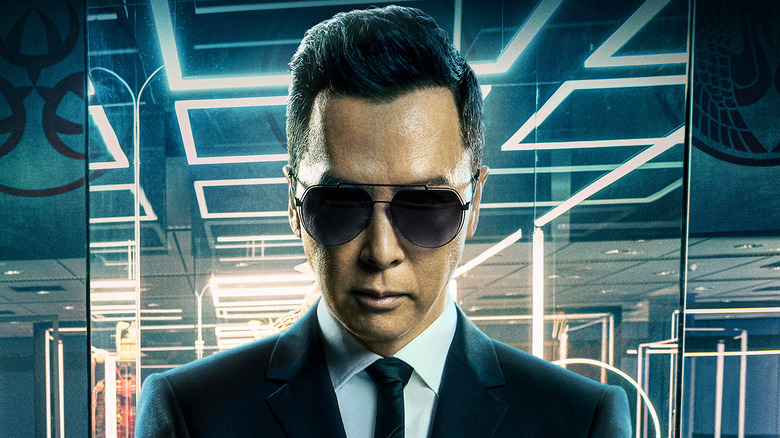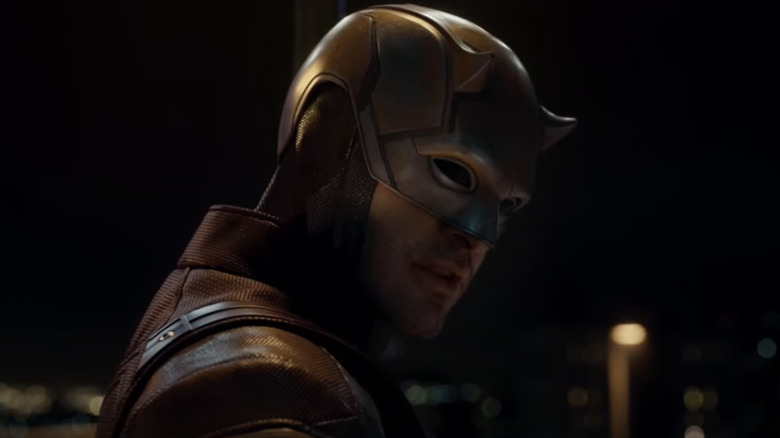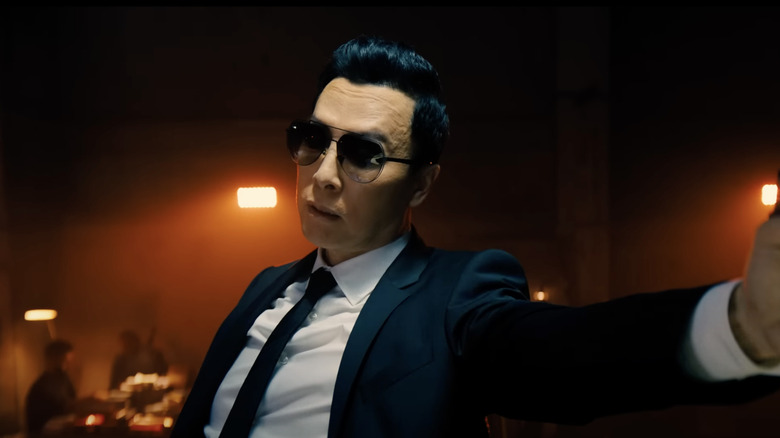John Wick: Chapter 4 - Caine Is A Refreshing Take On An Old Action Trope
From ultra-violent video games like "Mortal Kombat" to children's television shows like "Avatar: The Last Airbender," the character archetype of the sightless martial arts master is a tried and true staple of the action genre. But why?
Why do action stories so often place a hero without sight at the center of their narrative? Some may argue it's the same reason audiences go to the movies in the first place — we love to watch characters overcome obstacles. In the same way that watching Lt. Kaffee verbally corner his superior, Col. Jessup, in "A Few Good Men" can be just as exhilarating as seeing Jamie Tartt bury his ego to score a game-winning goal in "Ted Lasso," watching a fighter successfully compete without the use of one of their senses is thrilling, inspiring, and even cathartic. And yet, that doesn't begin to scratch the surface of why sightless masters make for such great action heroes.
To sum up the importance of these characters with platitudes about conquering adversity would be shallow and, well, wrong. Aside from the fact that being sightless does not inherently make one an underdog in real life or at the cinema, viewing their success through such a reductive lens not only misses what makes these characters great but threatens to ignore a crucial aspect of what makes any action hero worth rooting for. Overcoming an obstacle isn't enough — it's how the character overcomes them that truly matters. Few films understand this fact in relation to sightless fighters better than "John Wick: Chapter 4."
Almost every sightless action hero has one thing in common
When it was first announced that Donnie Yen's Caine would be yet another sightless martial arts master, it gave many fans pause. Though the trope was new to the "John Wick" universe specifically, it had already been done to death by several high-profile movies and TV shows before it. Even Yen himself expressed some apprehension; prior to that, he portrayed the sightless rebel Chirrut îmwe in "Rogue One: A Star Wars Story."
Arguably the most famous example of this trope is Marvel's Daredevil, who was recently revived by Charlie Cox in the Disney+ series "She-Hulk" in 2022. Meanwhile, a live-action remake of "Avatar: The Last Airbender" is currently in production at Netflix, and the project will eventually reintroduce audiences to the sightless Earthbender Toph Beifong.
While all of these characters have their fans, they share an unfortunate trait that holds them back from standing out from one another: they all have superpowers that essentially give them sight. Chirrut's connection to the force is so strong he barely needs to concern himself with the world around him; Toph can feel vibrations in the ground that map out her environment; Daredevil has superhuman echolocation; even Kenshi from "Mortal Kombat" uses telekinesis to "see."
In addition to undermining these characters' ability to accurately represent a group rarely depicted on screen, giving them supernatural sight is a lazy way to sidestep an interesting character challenge. Instead of avoiding the implications of a sightless fighter, films should embrace them with creativity and imagination — just as "John Wick: Chapter 4" has done through its use of Caine.
John Wick honors Caine by not ignoring his lack of sight
"John Wick: Chapter 4" immediately separates Caine from previous sightless fighters by actually letting him be sightless. Where Daredevil would parkour his way through complex environments, Caine has to make quick use of his cane to assess his surroundings during a fight; where Toph could touch the ground and see right where her enemies were, Caine carefully places doorbell sensors that ring whenever someone walks by.
When Caine pulls off these feats of strategic prowess, he isn't simply overcoming an obstacle — he is revealing to the audience that he is smarter, faster, and more unpredictable than any opponent John Wick has faced yet. Instead of trying to explain away his sightlessness like other films would, "Chapter 4" uses it to showcase the character's many capabilities. Just as John's skills are exemplified when he's put under pressure, it's Caine's ability to turn his lack of sight into a tactical advantage that makes him a truly compelling fighter.
Like the classic samurai hero Zatoichi (by whom he is clearly inspired), Caine is every bit as dangerous as characters like Kenshi and Daredevil. But by honoring his lack of sight and treating it like a normal aspect of Caine's everyday life rather than a divine superpower, "John Wick: Chapter 4" succeeds in portraying Caine as an unmatched action hero and a genuinely unique representation of the sightless martial arts master.


